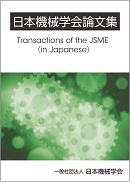Volume 89, Issue 919
Displaying 1-18 of 18 articles from this issue
- |<
- <
- 1
- >
- >|
Solid Mechanics and Materials Engineering
-
2023Volume 89Issue 919 Pages 22-00252
Published: 2023
Released on J-STAGE: March 25, 2023
Advance online publication: February 17, 2023Download PDF (2625K) -
2023Volume 89Issue 919 Pages 22-00289
Published: 2023
Released on J-STAGE: March 25, 2023
Advance online publication: March 06, 2023Download PDF (2277K) -
2023Volume 89Issue 919 Pages 22-00332
Published: 2023
Released on J-STAGE: March 25, 2023
Advance online publication: March 14, 2023Download PDF (2822K) -
2023Volume 89Issue 919 Pages 23-00041
Published: 2023
Released on J-STAGE: March 25, 2023
Advance online publication: March 10, 2023Download PDF (1785K)
Fluids Engineering
-
2023Volume 89Issue 919 Pages 22-00325
Published: 2023
Released on J-STAGE: March 25, 2023
Advance online publication: March 02, 2023Download PDF (4406K)
Thermal, Engine and Power Engineering
-
2023Volume 89Issue 919 Pages 22-00275
Published: 2023
Released on J-STAGE: March 25, 2023
Advance online publication: February 21, 2023Download PDF (2702K) -
2023Volume 89Issue 919 Pages 22-00293
Published: 2023
Released on J-STAGE: March 25, 2023
Advance online publication: February 20, 2023Download PDF (2658K) -
2023Volume 89Issue 919 Pages 23-00014
Published: 2023
Released on J-STAGE: March 25, 2023
Advance online publication: March 14, 2023Download PDF (2982K)
Dynamics & Control, Robotics & Mechatronics
-
2023Volume 89Issue 919 Pages 22-00228
Published: 2023
Released on J-STAGE: March 25, 2023
Advance online publication: February 22, 2023Download PDF (3603K) -
2023Volume 89Issue 919 Pages 22-00237
Published: 2023
Released on J-STAGE: March 25, 2023
Advance online publication: February 22, 2023Download PDF (3052K) -
2023Volume 89Issue 919 Pages 22-00301
Published: 2023
Released on J-STAGE: March 25, 2023
Advance online publication: February 22, 2023Download PDF (2015K) -
2023Volume 89Issue 919 Pages 22-00302
Published: 2023
Released on J-STAGE: March 25, 2023
Advance online publication: February 22, 2023Download PDF (1993K) -
2023Volume 89Issue 919 Pages 22-00310
Published: 2023
Released on J-STAGE: March 25, 2023
Advance online publication: March 06, 2023Download PDF (2914K)
Computational Mechanics
-
2023Volume 89Issue 919 Pages 22-00298
Published: 2023
Released on J-STAGE: March 25, 2023
Advance online publication: February 17, 2023Download PDF (3496K)
Design, Machine Element & Tribology, Information & Intelligent Technology, Manufacturing, and Systems
-
2023Volume 89Issue 919 Pages 22-00169
Published: 2023
Released on J-STAGE: March 25, 2023
Advance online publication: March 02, 2023Download PDF (2553K) -
2023Volume 89Issue 919 Pages 22-00340
Published: 2023
Released on J-STAGE: March 25, 2023
Advance online publication: March 07, 2023Download PDF (2557K)
Bio, Medical, Sports and Human Engineering
-
2023Volume 89Issue 919 Pages 22-00295
Published: 2023
Released on J-STAGE: March 25, 2023
Advance online publication: February 24, 2023Download PDF (2995K)
Environmental and Process Engineering, Safety
-
2023Volume 89Issue 919 Pages 22-00304
Published: 2023
Released on J-STAGE: March 25, 2023
Advance online publication: February 20, 2023Download PDF (5829K)
- |<
- <
- 1
- >
- >|
